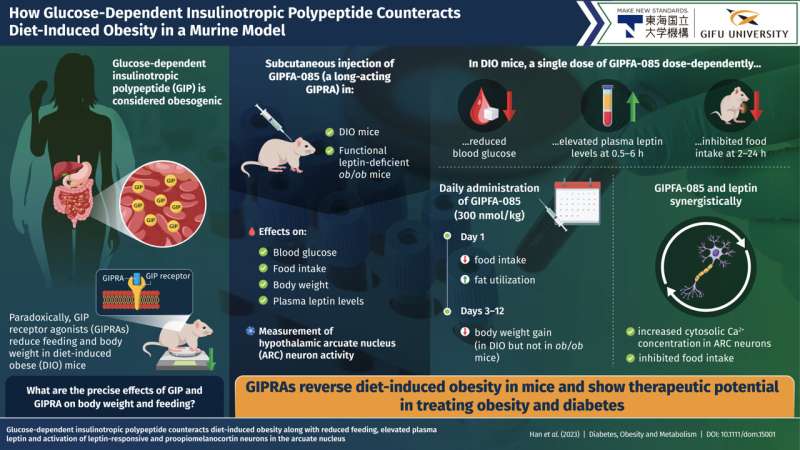This article has been reviewed according to Science X's editorial process and policies. Editors have highlighted the following attributes while ensuring the content's credibility:
fact-checked
proofread
Glucose-dependent insulinotropic polypeptide prevents diet-induced obesity in mice

The hormone glucose-dependent insulinotropic polypeptide (GIP) is considered obesogenic. In contrast, GIP receptor agonists (GIPRAs) have shown reduced feeding and body weight in an obese mouse model. Therefore, the precise effects exerted by GIP and GIPRAs remain elusive. Recently, researchers demonstrated acute feeding inhibition and lowered body weight in mice with diet-induced obesity treated with GIPFA-085, a long-acting GIPRA. Their findings provide a scientific basis for GIP therapy for diabetes and obesity.
Obesity, type 2 diabetes, and their associated comorbidities contribute to millions of deaths across the globe every year. While lifestyle interventions can decrease the progression of these diseases, there is a distinct lack of proven and safe treatments for obesity. Glucose-dependent insulinotropic polypeptide (GIP) is an incretin hormone released by the small intestine that stimulates insulin secretion upon eating food.
While some researchers have shown that GIP promotes obesity, others have presented contradictory evidence that GIP receptor agonists (GIPRAs), which essentially have the same function as GIP, prevent the disease. Therefore, there is a need to clarify the mechanisms and effects of GIP and GIPRA on body weight and feeding.
Recently, researchers from Japan were able to demonstrate that GIPFA-085, a long-acting GIPRA, acutely inhibited feeding and lowered the body weight of diet-induced obese (DIO) mice in a sustained manner. Dr. Toshihiko Yada from Kansai Electric Power Medical Research Institute and Gifu University Graduate School of Medicine led the research team that made this important discovery, which has been published in Diabetes, Obesity and Metabolism.
The team also consisted of Dr. Wanxin Han and Dr. Daisuke Yabe from Gifu University's Graduate School of Medicine and Center for One Medicine Innovative Translational Research and Dr. Yutaka Seino from Kansai Electric Power Hospital.
Says Dr. Yada, who is the corresponding author of the study, "GIP has been considered obesogenic by some researchers. In contrast, GIPRAs, alone and in combination with glucagon-like peptide-1 (GLP-1) receptor agonists, reportedly reduce feeding and body weight in diet-induced obese (DIO) mice. In this regard, this study aimed to clarify the effects of GIPRA on feeding and body weight."
The team examined the short- and long-term effects of subcutaneous GIPFA-085 on measurable biological parameters such as blood glucose, food intake, body weight, respiratory exchange ratio, and plasma leptin levels in DIO mice. They also conducted similar experiments on ob/ob mice that were genetically programmed to exhibit leptin dysfunction. Leptin—a hormone synthesized by fat cells—controls satiety and energy storage by providing feedback to the central nervous system.
The administered GIPFA-085 doses were as low as 30 nmol/kg or as high as 300 nmol/kg during these murine experiments. The team found that a single dose (30–300 nmol/kg) of subcutaneously injected GIPFA-085 reduced blood glucose, elevated plasma leptin levels at 0.5–6 h, and inhibited food intake at 2–24 h in DIO mice.
Dr. Yabe remarks, "A daily dose of GIPFA-085 (300 nmol/kg) not only inhibited food intake but also increased fat utilization on day 1, and reduced body weight gain on days 3–12 of the treatment. This observation was evident in DIO mice but not in ob/ob mice."
In addition, the injected GIPFA-085 demonstrated the coordination of the satiety-signaling leptin with the murine central nervous system through the regulation of intracellular calcium concentration ([Ca2+]i). GIPFA-085 inhibited feeding and sustainably lowered body weight in DIO mice via an increase in leptin and activation of the satiety neurons in the hypothalamic arcuate nucleus (ARC).
"GIPFA-085 increased [Ca2+]i in the ARC leptin-responsive and proopiomelanocortin (POMC) neurons. GIPFA-085 and leptin cooperated to increase [Ca2+]i in ARC neurons and inhibit food intake," says Dr. Seino.
In summary, by demonstrating the therapeutic potential of GIPRAs in a mouse model, this study could facilitate the development of GIP/GLP-1 dual agonists to treat diabetes and obesity. The study also provides an avenue for novel incretin-GIP-based therapy.
"By demonstrating the therapeutic potential of GIPRAs, our study could lead to an increased quality of life in patients with diabetes and obesity. Our study also provides hope to several patients with obesity, who are suffering from a lack of safe and effective treatment for the disorder," concludes Dr. Yada.
More information: Wanxin Han et al, Glucose‐dependent insulinotropic polypeptide counteracts diet‐induced obesity along with reduced feeding, elevated plasma leptin and activation of leptin‐responsive and proopiomelanocortin neurons in the arcuate nucleus, Diabetes, Obesity and Metabolism (2023). DOI: 10.1111/dom.15001




















